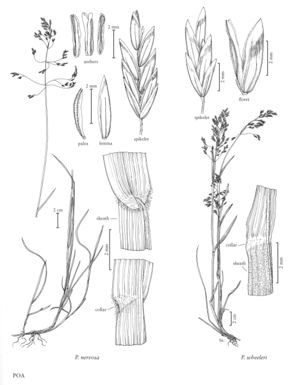Poa wheeleri
Plants perennial; densely to loosely tufted or with solitary shoots, shortly rhizomatous. Basal branching mainly extra-vaginal. Culms 35-80 cm, erect or the bases decumbent, terete or weakly compressed; nodes terete, 1-2 exserted. Sheaths closed for 1/3-1/4 their length, terete to slightly compressed, at least some proximal sheaths densely retrorsely scabrous, hispidulous, or softly puberulent for the upper 1/4 of their length, bases of basal sheaths glabrous, distal sheath lengths (1.4)1.7-4.6(6.2) times blade lengths; collars of proximal leaves glabrous or with hairs the same length as those of their sheaths; ligules 0.5-2 mm, smooth or scabrous, sometimes puberulent, truncate, those of the lower culm and innovation leaves 0.5-1.5 mm, abaxial surfaces scabrous to softly puberulent, truncate; innovation blades folded or involute, infrequently flat, moderately thick, soft, adaxial surfaces usually densely scabrous to hispidulous; cauline blades 2-3.5 mm wide, flat or folded, smooth or sparsely scabrous, glabrous or hispidulous, apices narrowly to broadly prow-shaped, blades gradually reduced distally or the middle blades longest, flag leaf blades 1-10 cm long. Panicles 5-12(18) cm, erect or nodding, ovoid to pyramidal, loosely contracted to open, with 20-70 spikelets, proximal internodes usually shorter than 3.5 cm; nodes with 2-5 branches; branches (1)1.7-6.5 cm, ascending to spreading or reflexed, lax, terete or weakly angled, sparsely to moderately scabrous, with 2-8(12) spikelets. Spikelets 5.5-10 mm, lengths to 3.5 times widths, laterally compressed, not sexually dimorphic; florets 2-7; rachilla internodes smooth or scabrous, glabrous or sparsely to densely hispidulous. Glumes 1/4 - 2/3(3/4) as long as the adjacent lemmas, lanceolate, distinctly keeled; lower glumes 1-3-veined, 1/4-1/2 as long as the adjacent lemmas; calluses glabrous; lemmas 3-6 mm, lanceolate, distinctly keeled, keels and marginal veins glabrous or softly puberulent to short-villous, intercostal regions glabrous or hispidulous, infrequently puberulent, smooth or finely scabrous, lateral veins obscure to moderately prominent, margins glabrous, apices acute; palea keels scabrous, intercostal regions glabrous; anthers usually vestigial (0.1-0.2 mm) or aborted late in development and up to 2 mm, rarely normal. 2n = 56, 61, 62, 63, 64, 66, 61, 70, ca. 74, 75, 79, 80, 81, 87, 89, 90, 91.
Distribution
Colo., N.Mex., Wash., Wyo., Utah, Calif., Oreg., Mont., Alta., B.C., Man., Sask., Idaho, Nev.
Discussion
Poa wheeleri is common at mid- to high elevations, generally on the east side of the coastal mountains from British Columbia to California, and from Manitoba to New Mexico. It generally grows in submesic coniferous forests to subalpine habitats. Most plants have densely retrorsely pubescent or scabrous sheaths, involute innovation blades that are pubescent adaxially, and pistillate florets.
Poa wheeleri, a high polyploid apomictic species, probably arose from hybridization between P. cusickii (p. 559) and another member of the Poa nervosa complex. It resembles P. rhizomata (see next) and P. chambersii (p. 548) more than P. nervosa sensu stricto (see previous). It differs from P. chambersii in having at least some proximal sheaths that are densely retrorsely scabrous or pubescent (sometimes obscurely so), and folded or involute innovation blades that are scabrous to hispidulous on the adaxial surfaces. For a comparison with P. nervosa, see p. 545. Natural hybrids have been found between P. wheeleri and P. pratensis (p. 522).
Selected References
None.
